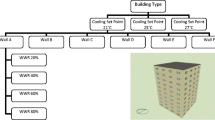Abstract
Massive walls exposed to the natural climate without special rain protection show a dynamic moisture equilibrium governed by the alternating events of rain and sunshine. The moisture further reduces the rather low insulation level of the walls. Therefore, thermal insulation measures have to be taken in order to improve the hygienic conditions and the thermal performance of the building. The influence of interior and exterior insulations on the hygrothermal behaviour of such walls can be determined with the aid of a recently developed computer program which has been experimentally validated by comparison with field tests. The results show that an exterior insulation leads to the drying of the wall, with the drying rate depending on the vapour permeability of the insulation system. An interior insulation, however, results in a rising water content of the wall due to the decreasing masonry temperature. This effect is almost independent of the vapour permeability of the insulating material. While an exterior insulation also improves the thermal resistance of the masonry, an interior insulation has the opposite effect and increases the frost damage risk. Therefore, the interior insulation of exposed walls should be combined with rain protection measures at the facade.
Résumé
Des murs massifs exposés au climat naturel sans protection particulière démontrent un équilibre hygrique dynamique gouverné par l'alternance de pluie et d'insolation. L'humidité réduit la résistance thermique déjà peu élevée des murs. Des mesures d'isolation sont nécessaires pour améliorer les conditions hygiéniques et la qualité thermique du bâtiment. L'influence de l'isolation par l'extérieur et par l'intérieur sur le comportement hygrothermique de ces murs peut être déterminée au moyen d'un nouveau programme informatique validé par une comparaison expérimentale. Les résultats montrent qu'une isolation par l'extérieur facilite le séchage du mur, le taux de séchage dépendant de la perméabilité à la vapeur du système isolant. Cependant, l'isolation par l'intérieur mène à une teneur en eau plus élevée à cause de la réduction de la température de la maçonnerie. Cet effet est presque indépendant de la perméabilité à la vapeur du matériau isolant. Contrairement à l'isolation par l'extérieur, qui améliore la résistance thermique de la maçonnerie, l'isolation par l'intérieur a l'effet opposé et accroît le risque de dégradation par le gel. Pour cette raison, on doit joindre à l'isolation par l'intérieur des murs exposés des mesures de protection contre la pluie sur la façade.
Similar content being viewed by others
References
Hens, H., ‘Heat, Air and Moisture Transfer in Insulated Envelope Parts’, Final report of IEA-Annex 24, Task 1: Modelling, Leuven 1996, ISBN 90-75741-02-2.
Künzel, H.M., ‘Simultaneous Heat and Moisture Transport in Building Component’, IRB-Verlag Stuttgart 1995, ISBN 3-8167-4103-7.
Künzel, H.M. and Kiessl, K., ‘Drying of brick walls after impregnation’,Internationale Zeitschrift für Bauinstandsetzen 2 (1996) 87–100.
Krus, M., Künzel, H.M. and Kiessl, K., ‘Feuchtransportvorgänge in Stein und Mauerwerk’, Bauforschung für die Praxis, IRB-Verlag Stuttgart, 1996.
Künzel, H.M., ‘Feuchteverhalten von Wärmedämmverbundsystemen mit Keramikplatten auf baufeuchten Außenwänden’, IBP-report HTB-4/1996.
Author information
Authors and Affiliations
Rights and permissions
About this article
Cite this article
Künzel, H.M. Effect of interior and exterior insulation on the hygrothermal behaviour of exposed walls. Mat. Struct. 31, 99–103 (1998). https://doi.org/10.1007/BF02486471
Received:
Accepted:
Issue Date:
DOI: https://doi.org/10.1007/BF02486471




